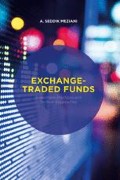Abstract
This chapter highlights three exchange-traded fund (ETF) trading strategies: one based on futures, where an individual enters a contract to buy or sell ETFs at a specified price and delivery date; another on margin trading, in exchange for making a small payment known as the “initial margin;” and the third on what’s commonly known as “barbelling,” an investment strategy best described as a balancing act between investments deemed safe and those considered a greater risk.
Access this chapter
Tax calculation will be finalised at checkout
Purchases are for personal use only
Notes
- 1.
It is currently known as the PowerShares QQQ ETF (QQQ), although it still tracks the NASDAQ-100 Index and has been managed by Invesco since March 21, 2007.
- 2.
The CME and the Chicago Board of Trade merged in July 2007 to become the CME Group Inc.
- 3.
Trading is conducted from Sunday evening through Friday afternoon based on information provided 24 hours a day by a data center operated by the CME Group.
- 4.
Traditionally, commodity futures are settled with physical delivery on expiration, while securities futures use cash settlements or physical delivery of ETF shares.
- 5.
These accounts are “segregated” in accordance with Section 4d(a)(2) of the Commodity Exchange Act and Securities and Exchange Commission Rule 1.20.
- 6.
Securities futures are jointly regulated by the Commodity Futures Trading Commission and the Securities and Exchange Commission, whereas physical ETFs are exclusively regulated by the Securities and Exchange Commission (SEC).
- 7.
On Monday, August 24, 2015, a computer outage at Bank of New York Mellon Corp. (BNY), unrelated to the market turbulence of the time, forced fund sponsors to sort out pricing data manually to provide investors with the values of their holdings. The computer glitch caused significant mispricings of 1% or more, hindering investors’ ability to trade in and out of ETFs and other popular funds. Considering that BNY is the largest fund custodian in the world by assets, the pricing snag affected several big money managers and fund companies.
- 8.
These could be any other liquid ETF futures contracts.
- 9.
http://www.online-futures-trading.co.uk/futures/index-futures/eurostoxx-50-fesx (as of August 30, 2015).
- 10.
Options contracts are the second vehicle.
- 11.
See Harrod, R.F., The Life Of John Maynard Keynes, New York: Harcourt Brace, 1951.
- 12.
Fama, E.F., and K.R. French, “Commodity Futures Prices: Some Evidence on Forecast Power, Premiums, and the Theory of Storage,” Journal of Business, 60(1) (January 1987), pp. 55–73.
- 13.
Deaton, A., and G. Laroque, “On the Behaviour of Commodity Prices,” Review of Economic Studies, 59(1) (January 1992), pp. 1–23.
- 14.
Erb, C.B., and C.R. Harvey, “The Tactical and Strategic Value of Commodity Futures.” Financial Analysts Journal, 62(2) (March/April 2006), pp. 69–97.
- 15.
Tang, K., and W. Xiong, “Index Investment and the Financialization of Commodities,” Financial Analysts Journal, 68(6) (November/December 2012), pp. 54–74.
- 16.
- 17.
In the case of bond ETFs, financial leverage allows a greater par value.
- 18.
- 19.
- 20.
This suggests that the broker has discretion in making a margin call. A purist will rightly argue that this is correct only where the broker sets margin requirements in excess of regulations, in which case there might be some discretionary room.
- 21.
Contrary to a margin account, where ETF shares can be bought and sold on credit, in a cash account all transactions are made on a strictly cash basis.
- 22.
Author information
Authors and Affiliations
Copyright information
© 2016 The Author(s)
About this chapter
Cite this chapter
Meziani, A.S. (2016). Other ETF Investment Strategies and Applications. In: Exchange-Traded Funds. Palgrave Macmillan, London. https://doi.org/10.1057/978-1-137-39095-0_14
Download citation
DOI: https://doi.org/10.1057/978-1-137-39095-0_14
Published:
Publisher Name: Palgrave Macmillan, London
Print ISBN: 978-1-137-39094-3
Online ISBN: 978-1-137-39095-0
eBook Packages: Economics and FinanceEconomics and Finance (R0)

